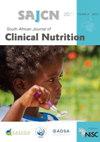Field-testing of the revised, draft South African Paediatric Food-Based Dietary Guidelines amongst mothers/caregivers of children aged 0–12 months in the Breede Valley sub-district, Western Cape province, South Africa
IF 0.6
Q4 NUTRITION & DIETETICS
引用次数: 1
Abstract
Objectives: To assess the appropriateness and understanding of the revised, draft South African Paediatric Food-Based Dietary Guidelines (SA-PFBDGs) amongst mothers/caregivers of children aged 0–12 months. Exposure to guidelines with similar messages, barriers and enablers to following of the guidelines were also assessed. Design: Qualitative data were collected from 14 focus-group discussions (FGDs), conducted in isiXhosa (n = 5), English (n = 4) and Afrikaans (n = 5), totalling 73 mother/caregiver participants. Setting: Worcester, Breede Valley sub-district, Western Cape province. Subjects: The study population included mothers/caregivers who were older than 18 years. Results: The majority of participants had previous exposure to variations of messages similar to the revised, draft SA-PFBDGs. Health platforms and practitioners (community health centres, antenatal classes, nurses, doctors) and social networks and platforms (family, magazines, radio) were mentioned as primary sources of information. Barriers to following the messages included: inconsistent messages (mainly communicated by healthcare workers), contrasting beliefs and cultural/family practices, limited physical and financial access to resources, poor social support structures and the psycho-social and physical demands of raising a child. Conclusion: The revised, draft SA-PFBDGs for the age range 0–12 months have been field-tested in English, Afrikaans and isiXhosa. The messages in some of the revised, draft SA-PFBDGs were not understood by the participants, indicating that a degree of rewording should be considered to facilitate understanding of the guidelines by the public. The National Department of Health should consider the findings of this study, and use these standardised messages to optimise infant and young child feeding.在南非西开普省Breede Valley街道0-12个月儿童的母亲/照料者中对修订后的《南非儿童食源性膳食指南》草案进行实地测试
目的:评估0-12个月儿童的母亲/照顾者对修订后的南非儿童食品膳食指南(sa - pfbdg)草案的适当性和理解。还评估了对具有类似信息的指导方针的接触情况、遵循指导方针的障碍和推动因素。设计:从14个焦点小组讨论(fgd)中收集定性数据,这些讨论以isiXhosa语(n = 5)、英语(n = 4)和南非荷兰语(n = 5)进行,共有73名母亲/照顾者参与者。环境:西开普省伍斯特,布莱德谷分区。研究对象:研究人群包括18岁以上的母亲/照顾者。结果:大多数参与者之前都接触过类似于修订后的sa - pfbdg草案的信息变化。保健平台和从业人员(社区保健中心、产前班、护士、医生)以及社会网络和平台(家庭、杂志、电台)被认为是主要的信息来源。遵循这些信息的障碍包括:不一致的信息(主要由卫生保健工作者传达)、不同的信仰和文化/家庭习俗、有限的物质和经济资源、不良的社会支持结构以及抚养孩子的心理-社会和身体需求。结论:修订后的年龄范围为0-12个月的sa - pfbgs草案已在英语、南非荷兰语和伊索萨语中进行了实地测试。一些经修订的sa - pfbdg草案中的信息没有被与会者理解,这表明应该考虑在一定程度上重新措辞,以促进公众对指南的理解。国家卫生部应该考虑这项研究的结果,并使用这些标准化的信息来优化婴幼儿喂养。
本文章由计算机程序翻译,如有差异,请以英文原文为准。
求助全文
约1分钟内获得全文
求助全文
来源期刊

South African Journal of Clinical Nutrition
NUTRITION & DIETETICS-
CiteScore
2.50
自引率
9.10%
发文量
21
期刊介绍:
1.The Journal accepts articles from all basic and applied areas of dietetics and human nutrition, including clinical nutrition, community nutrition, food science, food policy, food service management, nutrition policy and public health nutrition. 2.The Journal has a broad interpretation of the field of nutrition and recognizes that there are many factors that determine nutritional status and that need to be the subject of scientific investigation and reported in the Journal. 3.The Journal seeks to serve a broad readership and to provide information that will be useful to the scientific community, the academic community, government and non-government stakeholders in the nutrition field, policy makers and industry.
 求助内容:
求助内容: 应助结果提醒方式:
应助结果提醒方式:


